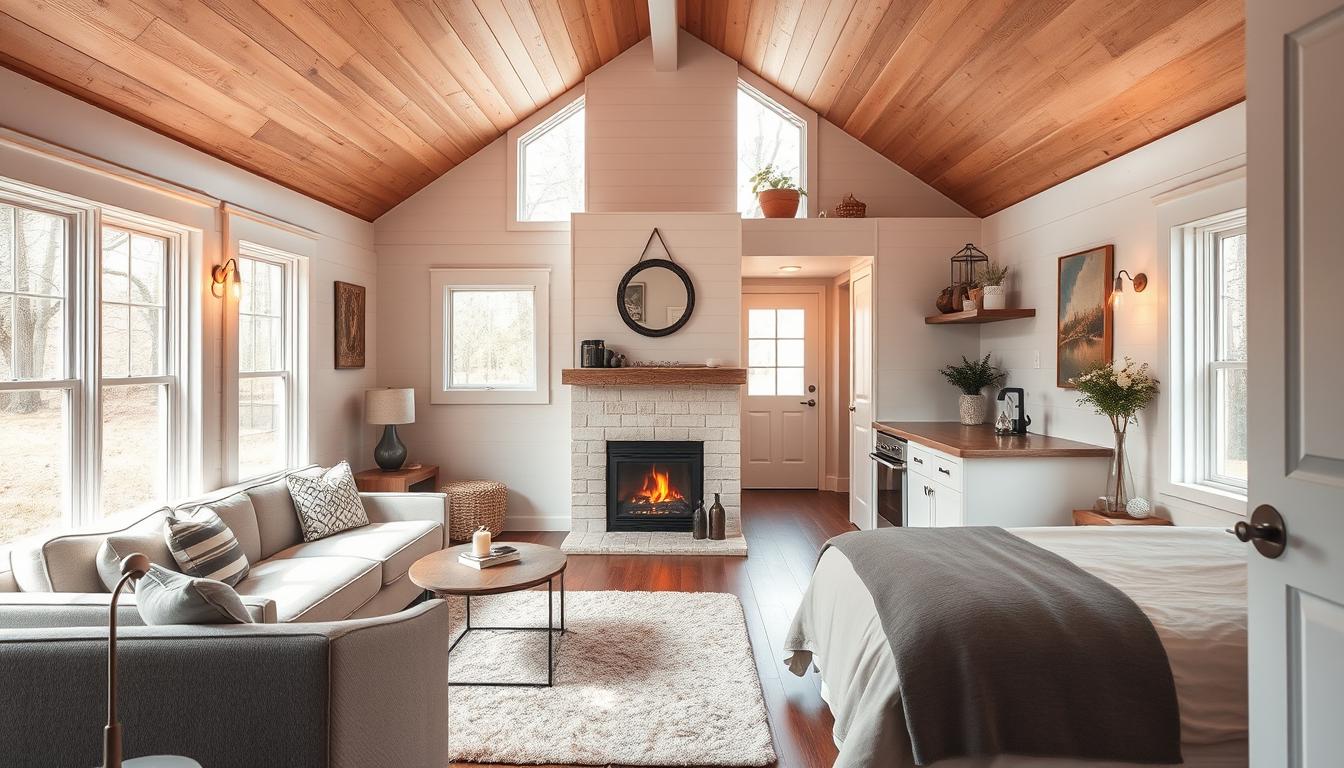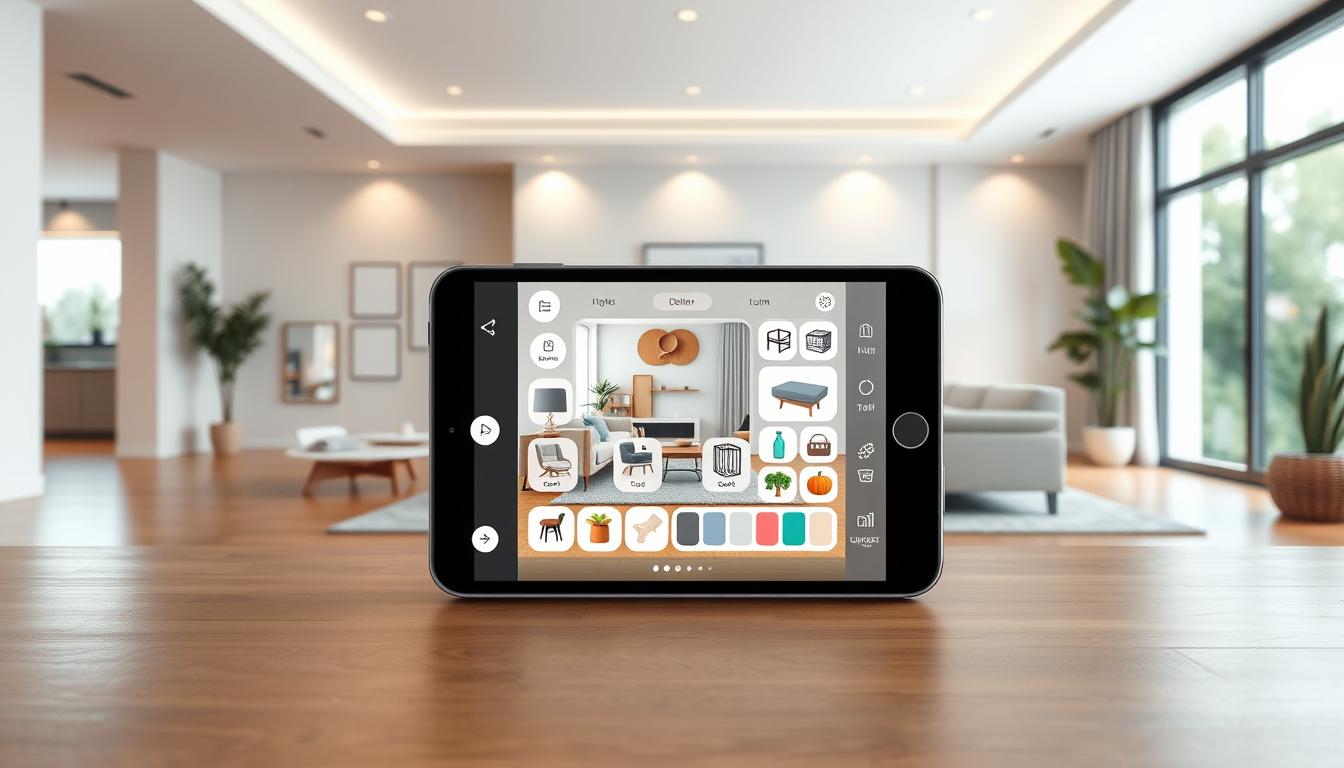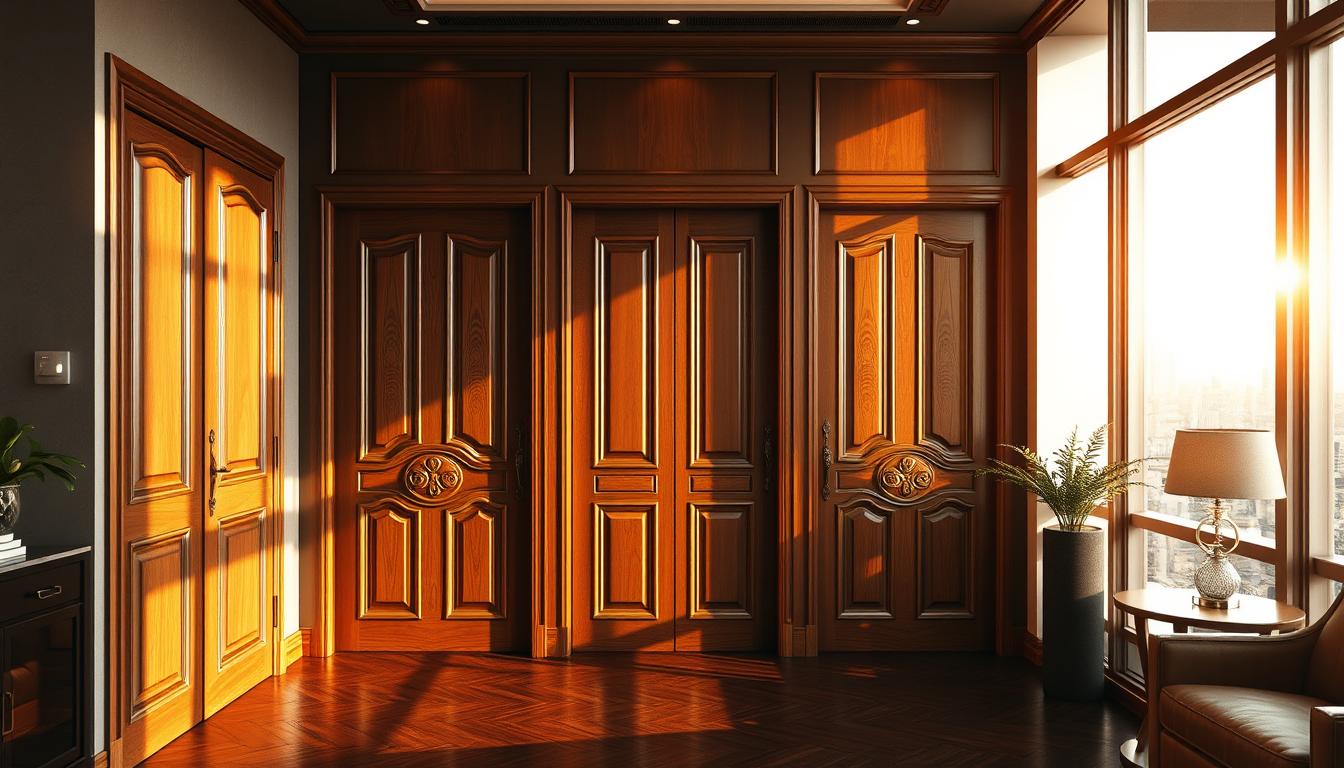Did you know a well-planned small house décor can make your space feel bigger? The right strategies can turn your small living area into a cozy, stylish home. It all starts with cozy home interior ideas that are both functional and beautiful.
We get the challenges of home interior design for small house settings. We’re here to help you through it. Our expert advice will guide you to create a space that’s both beautiful and functional, showing off your personal style.
Key Takeaways
- Optimize your space with multifunctional furniture.
- Choose a color palette that creates the illusion of more space.
- Utilize vertical space to maximize storage.
- Select lighting that enhances the ambiance of your small home.
- Incorporate textures and patterns to add depth to your décor.
Understanding the Challenges of Small Space Design
Designing a small space comes with its own set of challenges. But with the right strategies, these can be overcome. It’s key to understand these challenges to make a small home both functional and stylish.
Many think small homes are limited in what they can be. But, even the smallest spaces can be made cozy and inviting with the right approach.
Common Misconceptions About Small Interiors
Some believe small interiors are dull and lack character. But, this is not true. Compact living can be stylish and functional, just like bigger homes, if you use the space well.
People often think small homes are too cramped for furniture or lack natural light. But, with smart space-saving solutions, small interiors can be just as cozy and welcoming.
Maximizing Functionality in Limited Space
To make the most of a small home, focus on tiny home interior design principles. Use furniture that does more than one thing, optimize storage, and choose a good color palette.
Here are some key strategies for making the most of limited space:
| Strategy | Description | Benefit |
|---|---|---|
| Multifunctional Furniture | Using furniture that serves more than one purpose | Saves space, increases functionality |
| Optimizing Storage | Utilizing vertical space and hidden storage | Reduces clutter, enhances flow |
| Color Palette | Selecting a palette that creates a sense of openness | Makes the space feel larger, improves ambiance |
By using these strategies, you can turn a compact living space into something both functional and stylish. As shown in the table, the right design choices can greatly improve your small home’s feel and function.
We’ll keep exploring design principles and strategies to help you create a beautiful and functional small home interior.
Key Principles of Small House Interior Design
Several key principles can greatly improve small house interior design. These principles help make small spaces feel open and peaceful.
Choosing the Right Color Palette
Choosing the right colors is crucial in small house design. Light colors can make a room look bigger. Dark colors can add coziness. Monochromatic schemes help by reducing visual clutter.
Using different shades of one color can make a space feel larger and more harmonious. Also, colors like blues and greens are calming. Colors like yellows and oranges can energize a space.
| Color | Effect on Space | Psychological Impact |
|---|---|---|
| Light Colors | Makes room appear larger | Bright and airy |
| Dark Colors | Creates coziness | Can feel oppressive if overused |
| Monochromatic | Reduces visual clutter | Harmonious and soothing |
Importance of Lighting
Lighting is key in small house design. It greatly affects how a room looks. Natural light is best because it makes spaces feel larger and more welcoming.
To get more natural light, use sheer curtains or blinds. Also, place mirrors opposite windows to reflect light. This makes the room brighter and more spacious.
Creating Visual Flow
Visual flow is how our eyes move through a space. In small homes, it’s important to avoid clutter. Use continuous flooring and avoid sudden changes in direction or texture.
Arrange furniture to guide the eye through the space. For example, a rug in the right spot can help direct the eye. This creates a sense of continuity.
By following these principles—choosing the right colors, using good lighting, and creating visual flow—you can make your small home feel bigger and more welcoming.
Furniture Selection for Compact Living
Choosing the right furniture is key for a stylish and functional small home. It’s important to find pieces that are both useful and look good. Each item should do more than one thing.
Multifunctional Furniture Choices
Multifunctional furniture is essential for small homes. Ottomans with storage are great because they offer a place to sit and keep things like blankets and books. A storage coffee table is also a smart choice, as it holds drinks and snacks while keeping things tidy.
Sofa beds and murphy beds are perfect for turning a living room into a bedroom quickly. They’re not only useful but also keep the home feeling open.
| Furniture Type | Multifunctional Features | Benefits |
|---|---|---|
| Ottoman | Storage compartment | Reduces clutter, provides additional seating |
| Coffee Table | Storage for items like magazines, remotes | Keeps living area organized |
| Sofa Bed | Converts from sofa to bed | Accommodates guests, saves space |
Space-Saving Furniture Options
There are many ways to save space in a small home. Wall-mounted shelves are a smart choice because they add storage without taking up floor space. They work well in kitchens and bedrooms, keeping things off the floor.
Nested furniture, like tables or chairs that stack, is also a great option. It’s perfect for small areas where space is tight.
By picking multifunctional and space-saving furniture, you can make your small home both stylish and practical. The goal is to find pieces that do more than one thing and use your space wisely.
Layout Planning for Small Homes
Layout planning is crucial in tiny home interior design. It helps create a cozy and inviting space. A well-planned layout can make a small home feel spacious and functional.
When planning, consider the space’s flow, functionality, and look. It’s about finding a balance between beauty and practicality. This way, your home will be both stunning and comfortable.
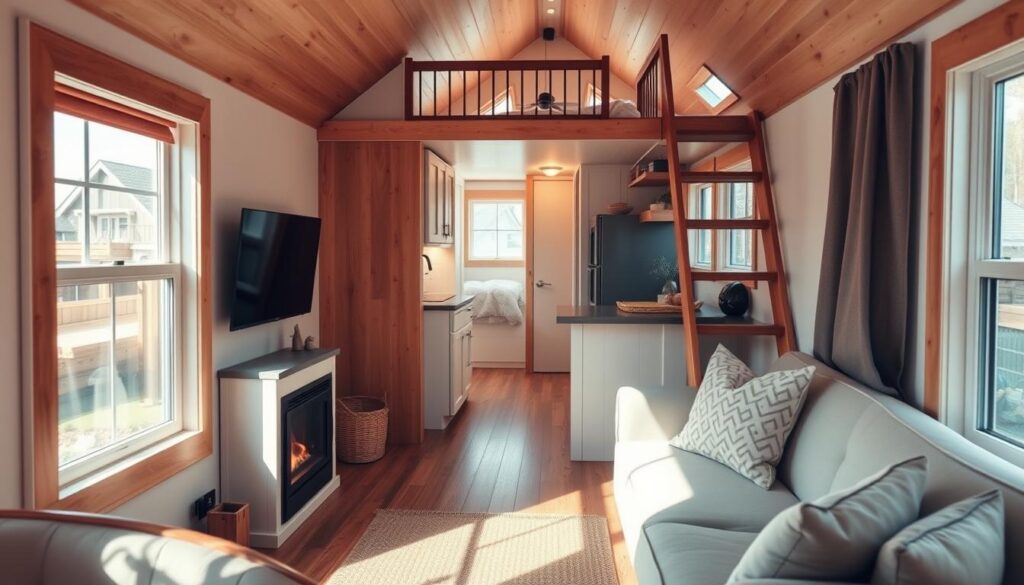
Open Floor Plans vs. Traditional Rooms
Choosing between an open floor plan or traditional rooms is a big decision. Open floor plans make a space feel larger by removing walls. This creates a sense of openness and connection.
- Open floor plans improve visibility and flow, making it easier to interact with others.
- But, they can lack privacy and may have noise issues.
Traditional rooms provide privacy and help define areas. Yet, they can make a space feel smaller and more divided.
Zones Within a Small Space
Creating zones in a small space is a smart way to organize it. By setting up zones for different activities, you make your home more efficient and comfortable. This approach helps you use your space better.
- First, think about the activities you’ll do in your home.
- Then, assign a zone for each activity.
- Use furniture and decor to mark each zone’s boundaries.
By using these strategies, you can make your home cozy and organized. For more small house organization tips, try different layouts and furniture setups. This will help you create a space that’s both efficient and welcoming.
The secret to great layout planning in small homes is to be creative and intentional. By doing so, you can make your cozy home interior feel spacious, functional, and inviting.
Incorporating Storage Solutions in Your Design
Finding enough storage in small homes is a big challenge. Let’s look at some smart ways to solve this problem. In small houses, every inch is precious. Clever storage can help keep your space tidy and organized.
Clever Storage Ideas for Small Areas
Being creative is essential in small spaces. Multifunctional furniture is a great way to save space and still have lots of storage. For example, ottomans with hidden spots or beds with drawers are very useful.
- Use under-bed storage bins for seasonal clothes or linens.
- Install shelves or storage units that reach the ceiling to use vertical space well.
- Choose furniture with legs to make your space look bigger and easier to clean.
Don’t forget the space behind doors. Over-the-door storage racks are perfect for hanging bags, accessories, or cleaning stuff. They keep things out of the way but still easy to reach.
Utilizing Vertical Space Effectively
Vertical space is often wasted in small homes. By putting up wall-mounted shelves or storage, you can free up floor space. This keeps your belongings organized and your floors clear.
| Storage Solution | Benefits |
|---|---|
| Wall-mounted shelves | Offers more storage without using floor space; great for decorations or books. |
| Vertical storage units | Uses vertical space well; perfect for storing linens, cleaning stuff, or office items. |
| Stackable containers | Flexible and can be used in closets, pantries, or on shelves; keeps things sorted and easy to find. |
To improve your storage, check out the image below. It shows how to use vertical space well in a small home.
By adding these storage ideas to your small home design, you can make your space more organized, useful, and stylish.
Enhancing Small Spaces with Décor
Decorating a small space needs careful thought to make it inviting. We’ll look at picking the right accessories and finding inspiration in minimalism. This will help your small home look stylish and be functional.
Selecting the Right Accessories
Choosing the right accessories is key in small house décor. They add personality without making the space cluttered. Multifunctional items are great because they do more than one thing. For instance, a storage ottoman can be a seat and a place to store things like blankets or books.
Think about your home’s style and color when picking accessories. Minimalist designs are good for small spaces because they keep things calm and uncluttered. But, you can also use bold pieces to add character, making sure they fit your décor theme.
| Accessory Type | Minimalist Option | Bold Statement |
|---|---|---|
| Rug | Simple, neutral-colored | Vibrant, patterned |
| Lighting | Simple pendant light | Colorful chandelier |
| Wall Art | Monochromatic prints | Bold, colorful abstract |
Finding Inspiration in Minimalism
Minimalism focuses on simplicity and less clutter. In small spaces, it makes the area feel bigger and calmer. To use minimalism in your décor, look for clean lines, less ornamentation, and a simple color scheme.
Minimalist décor opens up a space. Using mirrors strategically can make it seem even larger. Also, furniture with legs instead of bulky bases helps keep the space airy.
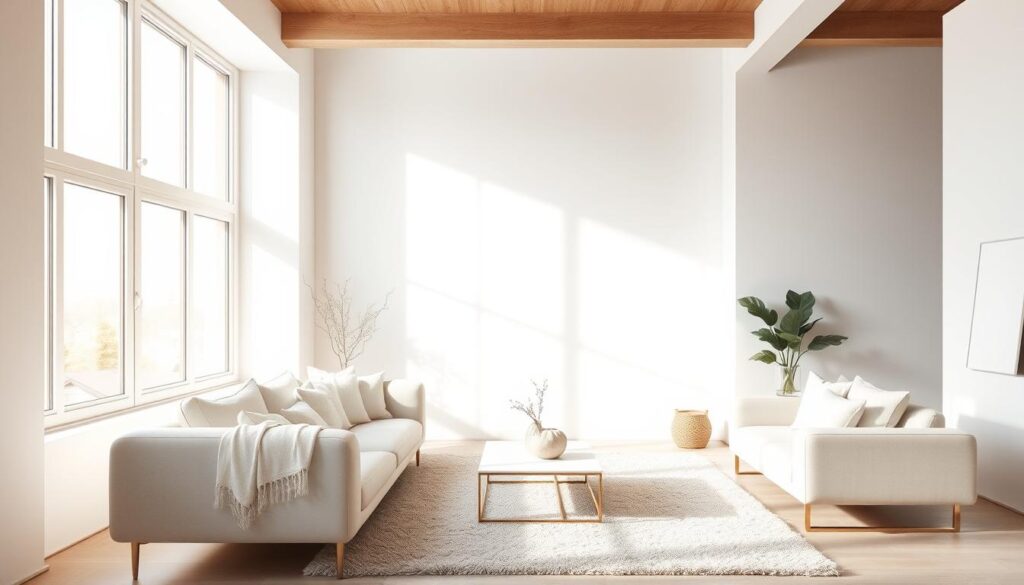
To make your small space even cozier, add soft textiles, warm lighting, and inviting colors. These elements create a welcoming feel.
Interior Design Styles That Work for Small Homes
Interior design styles can greatly impact the ambiance and functionality of small homes. By choosing the right style, homeowners can create a sense of spaciousness and comfort.
Modern and Contemporary Options
Modern and contemporary interior design styles are popular for small homes. They focus on clean lines, minimal ornamentation, and functionality. These styles often feature:
- Open floor plans that create a sense of spaciousness
- Monochromatic color schemes or subtle color contrasts
- Multifunctional furniture pieces
These elements work together to create a sense of flow and visual simplicity. This makes small spaces feel larger.
Cozy Rustic and Farmhouse Styles
For those who prefer a warmer, more traditional aesthetic, cozy rustic and farmhouse styles are ideal. Key characteristics include:
- Use of natural materials like wood and stone
- Warm, earthy color palettes
- Textiles such as throw blankets and rugs to add warmth
These elements create a cozy atmosphere. They make small homes feel inviting and comfortable.
Let’s compare the key features of modern/contemporary and rustic/farmhouse styles in the following table:
| Design Elements | Modern/Contemporary | Rustic/Farmhouse |
|---|---|---|
| Color Scheme | Monochromatic or subtle contrasts | Warm, earthy tones |
| Materials | Glass, metal, minimal wood | Natural wood, stone, brick |
| Furniture | Multifunctional, sleek designs | Comfortable, vintage, or antique pieces |
By understanding the strengths of each style, homeowners can make informed decisions. They can create a space that is both beautiful and functional.
Utilizing Mirrors for Illusion of Space
Mirrors are a simple yet effective way to make small rooms look bigger. They reflect light and images, making spaces appear larger and more welcoming. By placing mirrors wisely, you can enhance your home’s look and feel while making it seem more spacious.
Types of Mirrors to Consider
There are many types of mirrors for small homes. Each type has its own purpose and can create different effects.
- Large Wall Mirrors: Perfect for making rooms seem bigger. A large mirror on a wall reflects the room, expanding its appearance.
- Mirrored Furniture: Adds elegance and creates the illusion of more space. Furniture like dressers or console tables with mirrored surfaces works well.
- Decorative Mirrors: These add beauty while still offering the benefits of a mirror.
Placement Tips for Maximum Impact
Where you place mirrors is key to getting the best effect. Here are some tips for placing mirrors in your small home.
- Opposite Windows: A mirror opposite a window reflects natural light, making the room brighter and more spacious.
- Above Furniture: A mirror above a sofa or fireplace makes the ceiling seem higher and adds height.
- In Narrow Hallways: Mirrors in narrow hallways widen them, reducing the feeling of being closed in.
For more ideas on maximizing space, see our top tips for home interior design in small spaces.
| Mirror Type | Best Placement | Effect |
|---|---|---|
| Large Wall Mirrors | On a wall opposite a window | Reflects natural light, making the room appear larger |
| Mirrored Furniture | In place of regular furniture | Adds elegance and creates the illusion of more space |
| Decorative Mirrors | Above furniture or in a corner | Adds a decorative element while creating the illusion of space |
“Mirrors are a great way to make a room feel larger. They can be used to reflect light, create the illusion of more space, and add a decorative touch to your home.”
Using mirrors in your small home décor can make it feel more spacious and welcoming. Choose from large wall mirrors, mirrored furniture, or decorative mirrors. The key is to place them strategically for the best effect.
Bringing Nature Indoors with Plants
Plants do more than just look good; they clean the air and make spaces feel cozy. Adding plants to your home design can make it feel more welcoming. This fits well with minimalist home design, which values simplicity and natural elements.
Best Plants for Small Spaces
Choosing the right plants for small homes is key. Look for ones that do well indoors and don’t take up too much space. Here are some great picks:
- Snake Plant (Sansevieria Trifasciata): It’s great at cleaning the air and is easy to care for.
- ZZ Plant (Zamioculcas Zamiifolia): It can handle low light and doesn’t need much water, perfect for those who are always on the go.
- Pothos (Epipremnum aureum): This climber is easy to care for and can grow in different light conditions.
- Peace Lily (Spathiphyllum wallisii): It has beautiful white flowers and helps clean the air.
Maintenance Tips for Indoor Gardens
To keep your indoor plants healthy, follow these tips:
- Watering: Don’t overwater. Check the soil first.
- Lighting: Choose the right light for your plant. Some need sunlight, others prefer shade.
- Fertilization: Feed your plants with a balanced fertilizer when they’re growing.
- Pruning: Prune regularly to keep your plants looking good and growing well.
By following these tips and picking the right plants, you can improve your home interior design for small house. Adding plants is a smart small house organization tip that can make your space feel more organized and peaceful.
Personalizing Your Space
Making your home reflect your personality is crucial for a cozy feel. In a small house, every detail matters. Personal touches make your space welcoming and functional.
Customizing with Personal Touches
Adding personal touches makes your home feel more inviting. Here are some ideas:
- Display personal items such as family photos, heirlooms, or collectibles.
- Incorporate personal colors or patterns through accessories like throw pillows, rugs, or wall art.
- Add unique decorative pieces that reflect your hobbies or interests.
Balancing Trends with Timeless Style
It’s tempting to follow the latest trends, but balance is key. Here’s why:
- Invest in timeless furniture pieces that won’t go out of style soon.
- Use trendy items in accessories that can be easily replaced, such as vases, throw pillows, or wall decor.
- Blend modern trends with classic styles to create a unique look.
| Element | Trendy | Timeless |
|---|---|---|
| Furniture | Modern designs, bold colors | Classic shapes, neutral colors |
| Accessories | Seasonal items, bright colors | Simple decor, natural materials |
| Color Scheme | Bright, bold hues | Neutral, earthy tones |
| Decorative Style | Reflects current trends, often bold | Enduring styles, less susceptible to going out of fashion |
Final Tips for a Welcoming Small Home
As we wrap up our guide on designing a stylish small house interior, remember the final touches that make a house feel like home. For those living in compact spaces, the secret to a beautiful tiny home interior design is in the details.
Professional Guidance or DIY Enthusiasm
Homeowners often wonder if to hire professionals or do it themselves when it comes to small house interior design. Experts can offer valuable insights and save time, but DIY projects can be cheaper and more rewarding. Think about your budget, skills, and what you prefer. For more ideas and advice, check out Luxe Interior Co. for fresh interior design ideas.
Keeping Your Space Fresh
Regular updates are key to keeping your small home welcoming. Change your décor with the seasons and rearrange your furniture to keep things fresh. This way, your space will always feel new and inviting, ideal for compact living.

